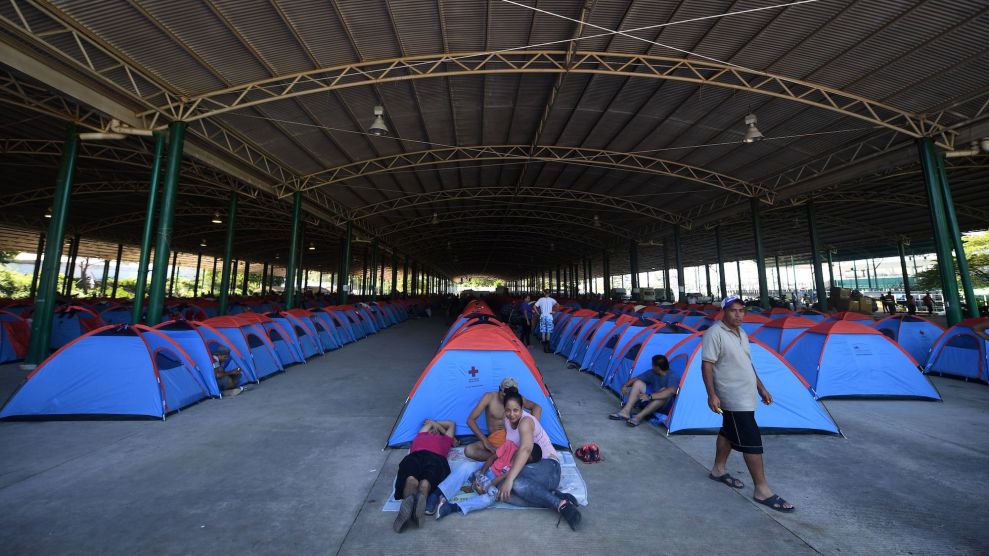
Honduran migrants heading in a caravan to the United States rest in tents in southern Mexico on Monday. Pedro Pardo/Getty
President Donald Trump is threatening to cut off aid to Central American countries as punishment for not stopping the migrant caravan that is (slowly) heading toward the United States. But doing so would likely have the opposite effect of what Trump claims to want.
Central American migrants are fleeing a variety of hardships, including intense poverty and violence. Experts say cutting off aid to their home countries would likely exacerbate those conditions and spur more people to leave in search of economic opportunity. Vicki Gass, a senior policy adviser for Central America at Oxfam America, says curtailing aid would “completely undermine everything that the US government has been trying to do since the first surge of migrants in 2014.” Rep. Eliot Engel, the top Democrat on the House Foreign Affairs Committee, said in a statement that it would lead to “precisely the opposite impact from what [Trump] intends.”
Trump tweeted Monday morning that the United States will begin to cut off or “substantially” reduce assistance to El Salvador, Guatemala, and Honduras because they “were not able to do the job of stopping people from leaving their country.” Trump made a less explicit threat in April, as another migrant caravan moved northward through Mexico.
As in April, there is no reason to believe Trump will be able to make good on his rhetoric. Congress is in charge of the budget, and it has already blocked the Trump administration’s efforts to dramatically cut aid to Central America. Engel says his office has already reached out to the Government Accountability Office to ensure aid to Central America keeps flowing.
In 2014, the Obama administration adopted a comprehensive approach to addressing the root causes of Central American migration, which include poverty and violence. Congress provided $700 million in aid for that effort in the 2017 fiscal year, with funds going toward initiatives such as public security and anti-violence programs for youth. Despite his focus on stopping unauthorized immigration, Trump tried to cut that to $460 million soon after taking office. Congress reduced assistance to $615 million instead. In its 2019 budget request, the Trump administration asked for only $436 million. Congress has again refused to make such a drastic cut.
George Redman, Oxfam’s Honduras director, is skeptical about how much impact US assistance has had so far in Honduras. “I’ve always thought that the indicator is how many people leave,” he explains. “And if your program is successful…then we wouldn’t be seeing what we’re seeing today.” The United States, which has a military base in Honduras, has backed the country’s anti-democratic leadership under both former President Barack Obama and Trump. “What Hondurans would say is, ‘This regime has been propped up by [the] US government, so the US government can’t complain if, as a result of the regime’s actions (or inactions), there are huge amounts of migrants now leaving because they don’t have jobs, they have no future, or they’re fleeing for their lives,'” Redman says.
But Adriana Beltrán, director for citizen security at the Washington Office on Latin America, points out that most of the Obama-era assistance did not begin to reach the region until last year. She emphasizes that the aid money is targeting problems that require a sustained response from the United States. “You’re not going to start seeing quick solutions,” she explains. “These are long-term challenges. And that’s why the president’s threat to cut off assistance is detrimental to the US’s own interests in the region.”
The proposed cuts are one of many signs the Trump administration is not focused on promoting long-term stability and economic growth in the region. The Department of Homeland Security is now phasing out the use of temporary protected status, which has allowed about 200,000 Salvadorans and more than 50,000 Hondurans to work legally in the United States for the past two decades. Remittances, many of which are sent by TPS holders, totaled nearly a fifth of both countries’ economies in 2016. The State Department has been unusually passive as Guatemalan President Jimmy Morales tries to dismantle an anti-corruption commission that is helping to restore the rule of law.
The Washington Post reported last week that Border Patrol agents apprehended nearly 110,000 family members in the 2018 fiscal year, breaking the previous record of 77,857 people set in 2016. The increase is driven by a roughly two-fold increase in migration from Guatemala, which has some of the deepest poverty in the Western Hemisphere. Maureen Meyer, director for migrant rights at the Washington Office on Latin America, says Guatemalan migrants are now escaping drought, the aftermath of a volcano eruption earlier this year, and years of blight in coffee crops. The country has one of the world’s highest rates of childhood stunting, according to the UN’s World Food Programme.
Migration from El Salvador, meanwhile, has fallen by about half this year. Meyer, Gass, and other Latin America experts aren’t sure why. Joanna Williams, director of education and advocacy for the Kino Border Initiative in Arizona, has heard from partners in El Salvador that more Salvadorans are heading south to Costa Rica and Panama. The decrease in family migration from El Salvador and the fact the caravan did not pass through the country did not stop Trump from calling for cutting its foreign aid.
There is no one factor that explains the recent increase in migration from Central America. Meyer emphasizes there are no simple solutions, either: “This administration is certainly not looking at this beyond just stopping people and making every effort to try to do that without really thinking about why they’re coming.”













